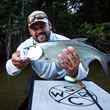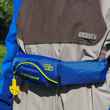I’m going to make a statement that may surprise you, but that I’m convinced is absolutely true.
Many fly fishers struggle to tell good fly casting from poor casting, or to distinguish a mechanically-sound fly casting stroke from a flawed stroke.
That sounds crazy, right? Every single fly fisher should be able to identify good casting. It’s the first thing we need to learn, because without that understanding — without knowing good casting when we see it — we have no clue what we’re trying to achieve with a fly rod in our hand.
Think about it. Skiers notice if another skier doesn’t know how to make a parallel turn. Basketball players taunt an opponent who can’t dribble or shoot. Fans jeer a pitcher who struggles to throw the ball over the plate. Yet when it comes to fly casting, nobody raises an eyebrow when a fly fisherman can’t execute a basic straight-line cast.
Why? Perhaps some of us have been trained, either consciously or subconsciously, to overlook poor form and mediocre results. Others don’t want to appear rude when a fellow angler comes up short. The number one reason, though, is that many of us never learn to differentiate good mechanics from poor mechanics, or solid casting from the less-than-stellar variety.
Which leaves us with a couple of very basic questions. What does a good cast look like? And how can we distinguish good casting from not-so-good casting?
First things first. We have to watch the fly line. Is it under control? Do the forward and back casts roll off the tip of the rod in a “U” or “V” shape that indicates a smooth transfer of energy? Does the line follow a straight path from back to front, and front to back? Or does the line take a more rounded or elliptical path that signifies a flawed casting stroke?
Take a moment to watch this short slow-motion video of an angler casting a dry fly. Notice how the line unrolls to the front, and to the back. That’s what we’re looking for with a basic dry fly cast. We want that smooth flow of energy from the angler, through the rod, down through the line and the leader, to the fly. If you’re making a short straight line cast and your line looks like the one in the video, you’re in good shape. If it doesn’t, you still have some work to do.
Now watch this slow motion video of a fly caster’s arm and hand. A mechanically-sound fly casting stroke — the stroke that the world’s best fly casters employ — looks like this for a short to medium length cast.
You’ll notice that the back cast starts as the elbow raises up, while the forward cast begins with the elbow’s descent. If you’re watching someone cast and their elbow is not going up and down at all, then they’re using less-than-optimal mechanics.
If you want to improve your own fly casting, pay attention to the casting stroke demonstrated up above. Just keep in mind that a longer line requires a longer stroke, while a shorter cast necessitates a shorter stroke.
As for what not to do ... please resist the urge to push your arm forward and then pull it back. The fly caster in the video below is demonstrating poor form that will have a negative impact on his results.
Nor do you want to cast using your elbow as a pivot point.
And you absolutely don’t want your casting to look like this, where it’s all wrist and no arm.
We’re all built a little differently, and it’s rare to find two people who cast exactly the same. That’s just the way life works. But everyone, from the novice to the expert, benefits from having a comprehensive understanding of a well-executed fly cast. Even if we never achieve perfection, it’s nice to move in a positive direction — and that all starts with a clear mental image of good casting and sound mechanics.































Comments
R. Cutter replied on Permalink
". . . does the line take a more rounded or elliptical path that signifies a flawed casting stroke?"
Fly casting is not fly fishing. Form should follow function and the idea that an elliptical path conveys a flawed stroke flies in the face of anyone who has ever cast a weighted nymph of streamer. A Belgium Swing is every bit a part of a controlled stroke as is a straight path stroke.
Pete Gordon replied on Permalink
Agree with all of that and not only when fishing a weighted fly,an elliptical path is also useful when casting in an adverse wind direction-blowing onto the casting shoulder.
As you say,there is fly casting and there is fly fishing -not always the same thing.
If you want to watch fly casting at it's best take a look at Carl Mcneil, -Bumcast on you tube,poetry in motion.
Rich replied on Permalink
Everyone can benefit from good casting videos but your comparisons to pitchers, basketball players misses by a wide margin. Ever see a side arm pitcher? A hook shot vs a jumper? There are many ways to get a job done that aren’t “ by the book”. Perhaps we don’t critique others or “raise an eyebrow “because they manage to get the job done and to enjoy their own methods.
Jon Christiansen replied on Permalink
I am not an expert on the fly cast, but I have studied it for many years. From what I can tell, there are two basic schools of thought. One school holds that the cast is initiated by the lift with a fixed elbow position, as demonstrated in this article and videos. The other school of thought, best exemplified by Lefty Kreh holds that the elbow and shoulder move, as sliding along a plane, in order to move the tip of the fly rod in a straight line. One of the videos here calls moving the elbow a fault and, in fact, it is IF you are teaching the elbow lift method. But not in the Kreh method.
Phil Gay replied on Permalink
As an FFI MCI and former BOG the mechanics demonstrated are accurate for a vertical caster. As others have said that is not the only way to cast. For example if I am casting side arm my elbow doesn’t go up and down but slides back and forward.
Interesting that the casters thumb comes up off the rod and the end of each forward cast. I see students doing that and try to discourage it.
Pages